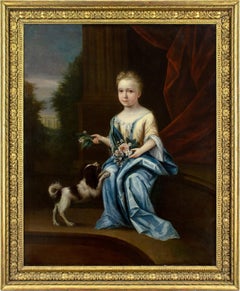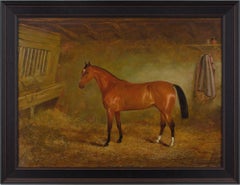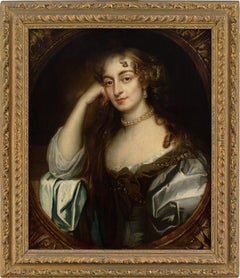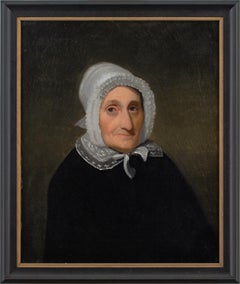Video Loading
Want more images or videos?
Request additional images or videos from the seller
1 of 14
Unknown16th-Century Italian School, Renaissance Portrait Of A Ladyc. 1575
c. 1575
$3,981.91List Price
About the Item
- Creation Year:c. 1575
- Dimensions:Height: 14.5 in (36.83 cm)Width: 12 in (30.48 cm)Depth: 2 in (5.08 cm)
- Medium:
- Movement & Style:
- Period:
- Condition:Cleaned. Craquelure throughout. The paint layer is stable. Areas of age-related discolouration. Frame with various marks and showing its age.
- Gallery Location:Cheltenham, GB
- Reference Number:1stDibs: LU2328216479552
About the Seller
5.0
Platinum Seller
Premium sellers with a 4.7+ rating and 24-hour response times
Established in 2017
1stDibs seller since 2023
245 sales on 1stDibs
Authenticity Guarantee
In the unlikely event there’s an issue with an item’s authenticity, contact us within 1 year for a full refund. DetailsMoney-Back Guarantee
If your item is not as described, is damaged in transit, or does not arrive, contact us within 7 days for a full refund. Details24-Hour Cancellation
You have a 24-hour grace period in which to reconsider your purchase, with no questions asked.Vetted Professional Sellers
Our world-class sellers must adhere to strict standards for service and quality, maintaining the integrity of our listings.Price-Match Guarantee
If you find that a seller listed the same item for a lower price elsewhere, we’ll match it.Trusted Global Delivery
Our best-in-class carrier network provides specialized shipping options worldwide, including custom delivery.You May Also Like
Italian Renaissance Gentleman Portrait of a Tailor Antique Oil Painting
Located in Cirencester, Gloucestershire
The Tailor
Continental School, 19th century
after the earlier Renaissance work by Giovanni Battista Moroni (16th century).
oil on canvas laid over board, framed
Framed: 16 x 12 inch...
Category
19th Century Renaissance Portrait Paintings
Materials
Oil
$1,113 Sale Price
20% Off
H 16 in W 12 in
18th Century French Oil Painting on Copper Portrait of Noble Lady
Located in Cirencester, Gloucestershire
Portrait of a Noble Lady
French School, early 1700's period
oil painting on copper, unframed
copper: 5 x 3 inches
condition: very good, minor paint fading and deteriation.
provenanc...
Category
Early 18th Century Renaissance Figurative Paintings
Materials
Copper
$848 Sale Price
20% Off
H 5 in W 3 in
Guardian Angel, 17th century Italian Old Master oil on copper
Located in Cirencester, Gloucestershire
Guardian Angel
Italian School, 17th century
Oil painting on copper, framed
Framed size: 12 x 10.5 inches
Fine quality early Italian Old Master oil on copper panel, dating to the 17t...
Category
17th Century Renaissance Portrait Paintings
Materials
Oil
$2,479 Sale Price
20% Off
H 12 in W 10.5 in D 1 in
Stylised Portrait, Peasant Girl, Impressionist Oil Painting
Located in Cirencester, Gloucestershire
Stylised Portrait, Peasant Girl, Impressionist Oil Painting
By European Schooled artist, Mid 20th Century
Oil painting on metal, framed
Framed size: 10.5 ...
Category
Mid-20th Century Renaissance Portrait Paintings
Materials
Oil
$661 Sale Price
20% Off
H 10.5 in W 8 in
Original abstract oil painting by prominent searchable artist Steve McElroy.
By Steve McElroy
Located in Dallas, TX
This artist's butterfly work is in the current Veranda Magazine with Jan Showers.
"Girl with the Hermes Scarf" by Steve McElroy. Oil on canvas, 22 x 28 inches, painted 2025. This ...
Category
2010s Renaissance Figurative Paintings
Materials
Oil, Canvas
$1,500
H 28 in W 22 in D 0.5 in
Renaissance Style Italian Old Master Painting Madonna & Child Tender Embrace
Located in Cirencester, Gloucestershire
19th/ early 20th Century Italian School
Madonna and Child
oil painting on canvas, unframed
canvas: 32 x 24 inches
provenance: private collection, UK
co...
Category
Late 19th Century Renaissance Portrait Paintings
Materials
Oil
$2,645 Sale Price
20% Off
H 32 in W 25 in
18th Century Italian Oil Madonna & Child with St. John the Baptist after Raphael
Located in Cirencester, Gloucestershire
Madonna and Child with St. John the Baptist
Italian artist, 18th century, after the earlier painting by Raphael
oil on wood panel, framed in an Empire, gilt moulded frame
Framed: 23 ...
Category
18th Century Renaissance Figurative Paintings
Materials
Oil
$4,959 Sale Price
20% Off
H 23 in W 22 in
St. Vincent Ferrer Preaching to the People of Salamanca
Located in New York, NY
Provenance:
Private Collection, New Jersey
The present painting depicts Saint Vincent Ferrer preaching from a raised pulpit to a group of seven peopl...
Category
15th Century and Earlier Renaissance Figurative Paintings
Materials
Oil, Wood Panel
$17,500
H 11.75 in W 8 in
Eli
Located in Mokena, IL
Eli, 2020
Oil on Panel with Carved and Gilded Frame, 11.5 x 13.5 inches
An embodiment of Renaissance portraiture, Varpucanskis’s “Eli” is distinguished by its gentle charm and mat...
Category
21st Century and Contemporary Renaissance Portrait Paintings
Materials
Gold Leaf
Ritratto con paesaggio
Located in Mokena, IL
Riratto con Paesaggio, 2019
Oil on Panel with Frame, 11 x 14 inches
A quiet and contemplative portrait painting, "Ritratto con Paesaggio", by Justas Varpucanskis, presents a sooth...
Category
21st Century and Contemporary Renaissance Portrait Paintings
Materials
Oil
More From This Seller
View AllJohn Verelst (Circle), Portrait Of A Young Lady With A Spaniel
By John Verelst
Located in Cheltenham, GB
This large early 18th-century full-length portrait depicts a seated young lady before a classical column and distant country house. It was formerly in the collection of Dalham Hall i...
Category
Early 18th Century Rococo Portrait Paintings
Materials
Canvas, Oil
19th-Century English School, Portrait Of A Bay Horse, Antique Oil Painting
Located in Cheltenham, GB
This charming mid-19th-century English school oil painting depicts a bay horse in a stable.
The British aristocracy has always had a passion for equestrian activities, and during th...
Category
Mid-19th Century Victorian Animal Paintings
Materials
Oil, Canvas
Jacob Huysmans (Attributed), Portrait Of A Lady With Pearls
By Jacob Huysmans
Located in Cheltenham, GB
This splendid mid-17th-century half-length portrait attributed to Flemish artist, Jacob Huysmans (c.1630-1696) depicts a lady wearing a brown and ivory dress decorated with pearls, t...
Category
Mid-17th Century Baroque Portrait Paintings
Materials
Canvas, Oil
Mid-19th-Century French School, A Pair Of Nanas, 2 x Oil Paintings
Located in Cheltenham, GB
This charming pair of mid-19th-century French School portraits depicts two grandmothers, both presumably widows, wearing black gowns and white bonnets.
Alas, the identity of these r...
Category
Mid-19th Century Portrait Paintings
Materials
Canvas, Oil
Early 19th-Century English School Portrait Of Samuel Jones Of Skeyton, Norfolk
Located in Cheltenham, GB
This fine early 19th-century English oil painting depicts Samuel Jones of Skeyton, Norfolk, smartly attired in a black coat with white cravat. The portrait was previously in the coll...
Category
1830s Portrait Paintings
Materials
Oil, Canvas
W.S. Cooper, A Bay Hunter & Groom In A Landscape
Located in Cheltenham, GB
This early 19th-century oil painting by English artist W.S. Cooper (act. 1832-1834) depicts a bay hunter and groom in a landscape with a hunt beyond.
Once hanging in a proud English...
Category
1830s Victorian Animal Paintings
Materials
Oil, Canvas
Recently Viewed
View AllMore Ways To Browse
Paolo Veronese
Antique Hairpin
Italian Paintings 16th Century
Italian Oil Painting Renaissance
Tooled Leather Panel
Oval Rococo Portrait
Portrait Habsburg
Princess Diana Painting
Procaccini Giulio Cesare
Robert Montgomery
Rosie Huntington Whiteley
Tarkay Oil Paintings
Tarkay Oil
Vintage Formula One Cars
Walter Stuempfig
Willem Wissing
Zhang Bo
1850 Portrait American



